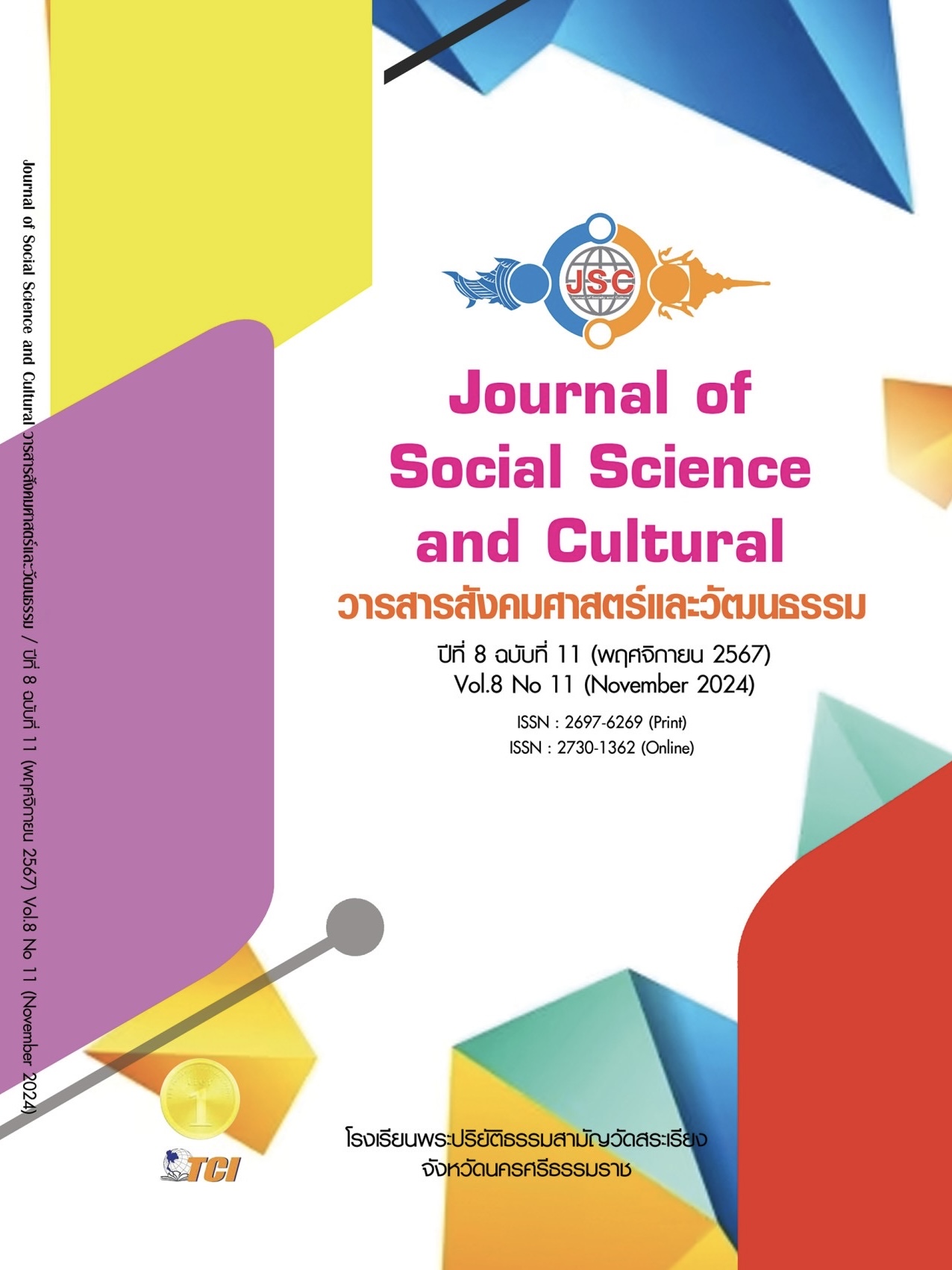GUIDELINES FOR PROMOTING LOCAL WISDOM IN TREATING DISEASES OF ORNAMENTAL FIGHTING FISH BY USING TERMINALIA CATAPPA LEAVES
Main Article Content
Abstract
The purpose of this research is to study the production process of medicines from terminalia catappa leaves and guidelines for promoting local wisdom in treating diseases of ornamental fighting fish by using terminalia catappa leaves. It is qualitative research. The research tool was an in-depth interview form and focus groups. The group of key informants was divided into 2 groups: a group of 6 people who raised ornamental fighting fish and a group of 6 people who sold water extracted from terminalia catappa leaves for fighting fish health, totaling 12 people. Data were collected by studying documents, conducting field studies and analyzed descriptively. The results of this research found that 1) The process of producing medicine from terminalia catappa leaves consists of 3 steps, 1) The process of selecting terminalia catappa leaves , 2) The process of producing fermented terminalia catappa leaves, and 3) Medicinal properties. 2) Guidelines for promoting local wisdom in treating diseases of ornamental fighting fish by using terminalia catappa leaves 2 main points: 1) Knowledge and wisdom 2) Economic and management aspects. To be used as information to request cooperation from the government sector to help support knowledge by preparing and distributing documents, publications, manuals, videos, as well as holding workshops on knowledge of diseases that occur with ornamental fighting fish. Prevention and treatment of ornamental fighting fish diseases using terminalia catappa leaves using local wisdom for ornamental fighting fish breeders. And the development of management and administration of the fighting fish distributor group, with a plan for selling fermented terminalia catappa leaves juice both in-store and online. In order to promote the fighting fish farming group, in addition to exporting fish to foreign countries, there is also economic expansion from terminalia catappa leaves through local wisdom.
Article Details
References
Department of Fisheries. (2016). Report on the Import and Export of Beautiful Aquatic Animals at the Suvarnabhumi Airport Marine Inspection Fiscal Year 2016. Samut Prakan: Fishquarantine at Suvarnabhumi, Department of Fisheries.
Department of Fisheries, Ministry of Agriculture and Cooperatives. (2019). Fighting fish, national aquatic animal. Retrieved July 24, 2024, from https://www4.fisheries.go.th/dof/news_local/16/118018.
Department of Fisheries, Ministry of Agriculture and Cooperatives. (2023). 5-year operational plan 2023-2027, Fisheries Department. Retrieved September 29, 2024, from http://file.fisheries.go.th/d/4aa6f595fd/
Department of Fisheries, Ministry of Agriculture and Cooperatives. (2024). Betta splendens Regan. Retrieved September 29, 2024, from https://www.eto.ku.ac.th/neweto/e-book/fish/fightingfish.pdf
Ko-sing, S. et al. (2018). Application of India almond (Terminalia cattappa l.) Leaves extract powder to inhibit bacteria (Aeromonas hydrophila) in Siamese fighting fish (Betta splendens Regan). Agricultural Science Journal, 49(3), 85-91.
Nation TV news team. (2022). Thai ornamental fish generate income of 700 million baht/year. Retrieved September 27, 2024, from https://www.bangkokbiznews.com/business/1007844
Office of Agricultural Research Development (Great National Organization). (2021). Malabar leaves are more useful than you think. Retrieved July 24, 2024, from https://blog.arda.or.th/639/other/%e0%b9%83%e0%b8%9a%e0%b8%ab%e0%b8%b9%e0%b8%81%e0%b8%a7%e0%b8%b2%e0%b8%87/
Phonphonpisit, A. et al. (2006). The study of Indian Almond Leaves (Terminalia catappa L.) on Siamese fighting fish (Betta splendens) and guppy (Poecilia reticulata) diseases treatment. In Research Report. Chulalongkorn University.
Pimolrat, P. et al. (2018). Extraction method and efficiency of Indian Almond Leave (Terminalia Catappa) Extract on Amount of ammonia reducing in water. In proceedings of 3rd National Conference on Informatics, Agriculture, Management, Bussiness Administration, Engineering, Science and Technology (Oral). CKMITL, Prince of Chumphon Campus.
Pimolrat, P. et al. (2022). Optimal concentrations of Tannin extract from Terminalia catappa leaves on tail Regeneration of Siamese fighting fish (Betta splendens). Journal of Agri. Research & Extension, 40(3), 106-115.
Rodpan, S. et al. (2020). Effect of Water pH from Dried Terminalia catappa Leaves on Increasing Male Ratio and Growth Performance of Halfmoon Fancy Betta Fish (Betta splendens). King Mongkut’s Agr. J., 38(4), 511-518.
Sermwatanakul, A. (2018). Developing of Siamese fighting fish (Betta splendens) to Thai National aquatic animal. Electronic Thai Fisheries Gazette, 1(1), 160-198.
Sukcharoenpong, S. et al. (2017). The potential of producing and marketing ornamental fish in asean economic community. Veridian E-Journal, Silpakorn Universit, 10(2), 2426-2443.
Tokrisna, R. et al. (2015). Capacity building for Thai fish farmers towards ASEAN economic community: Status and outlook. In Research report. Kasetsart University.
Yutthakosa, W. (2017). Malabar leaves for treating diseases in fighting fish. Retrieved July 19, 2024, from https://www3.rdi.ku.ac.th/?p=38122


